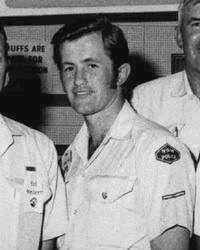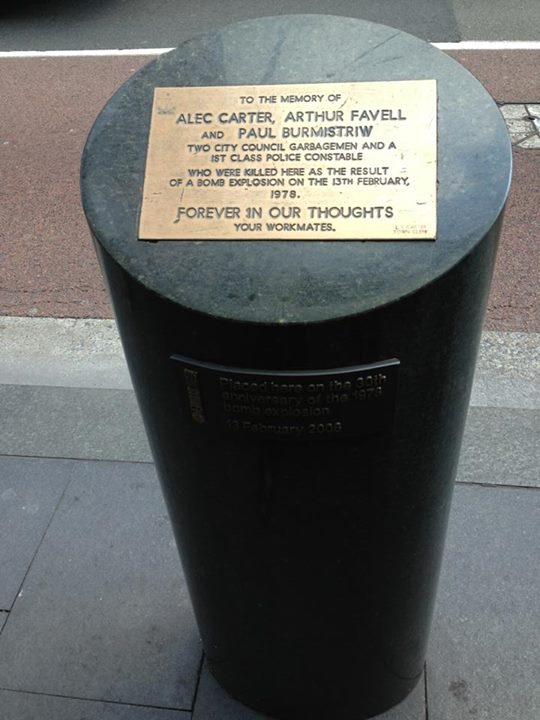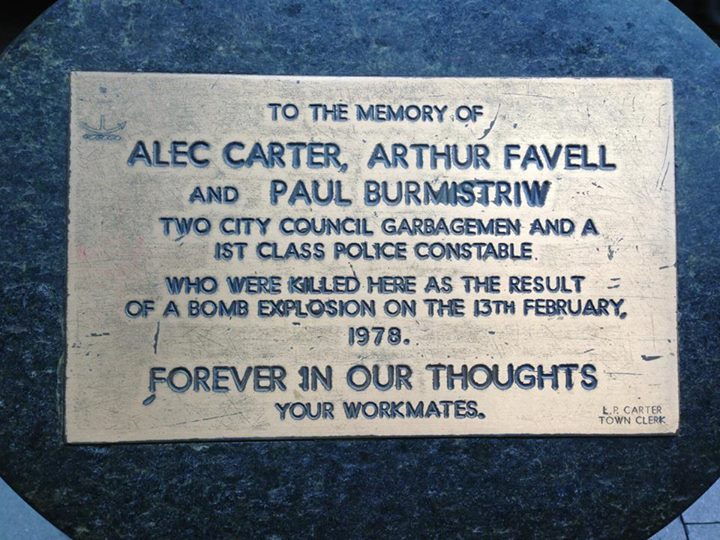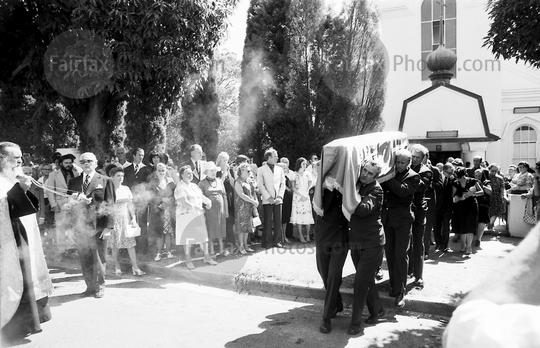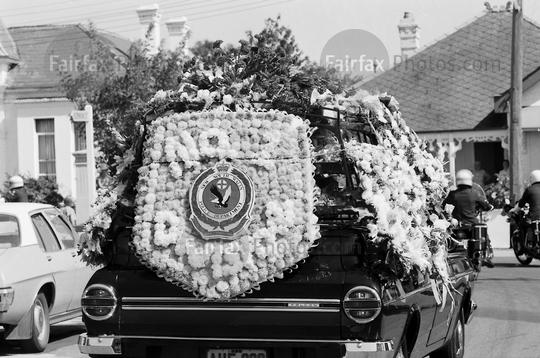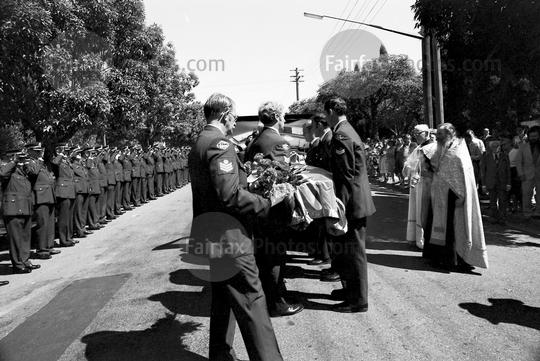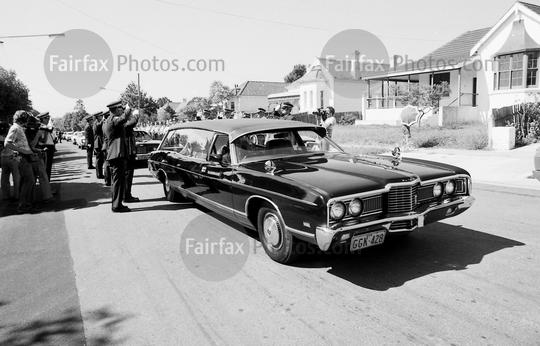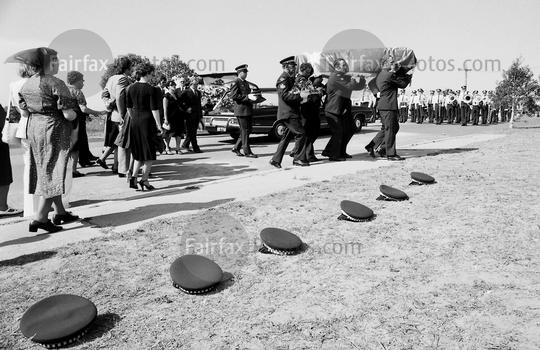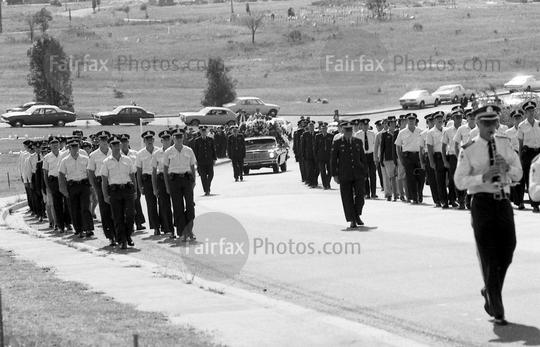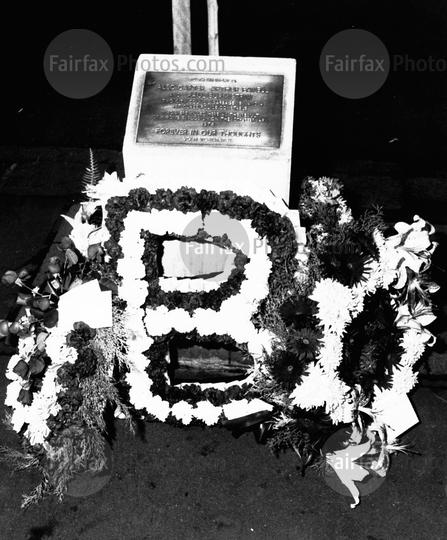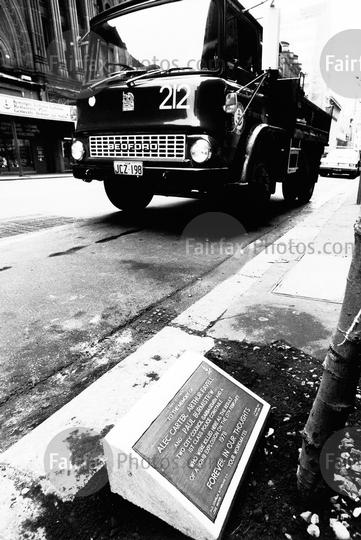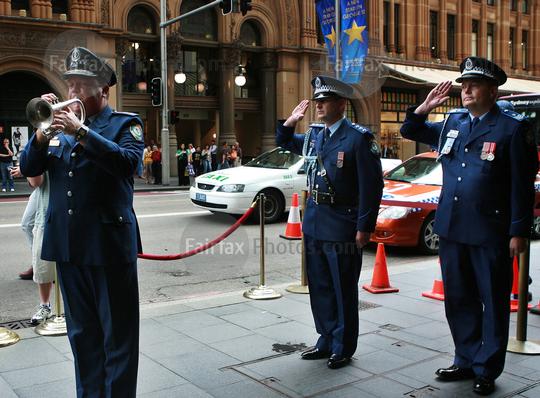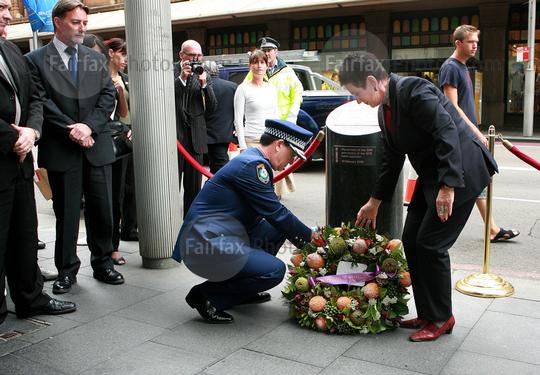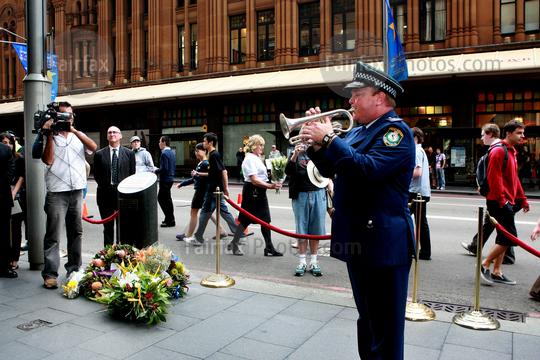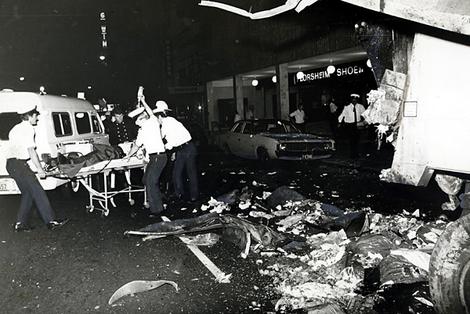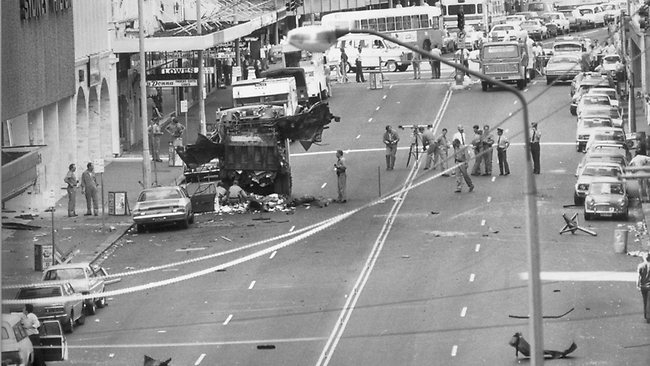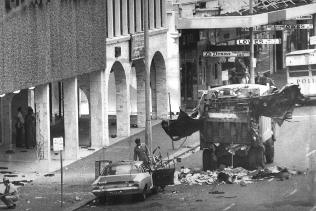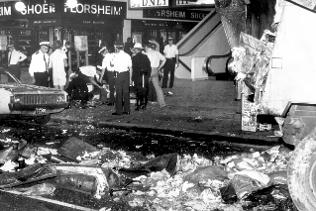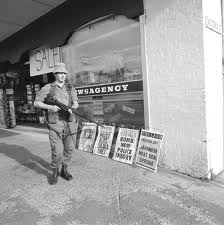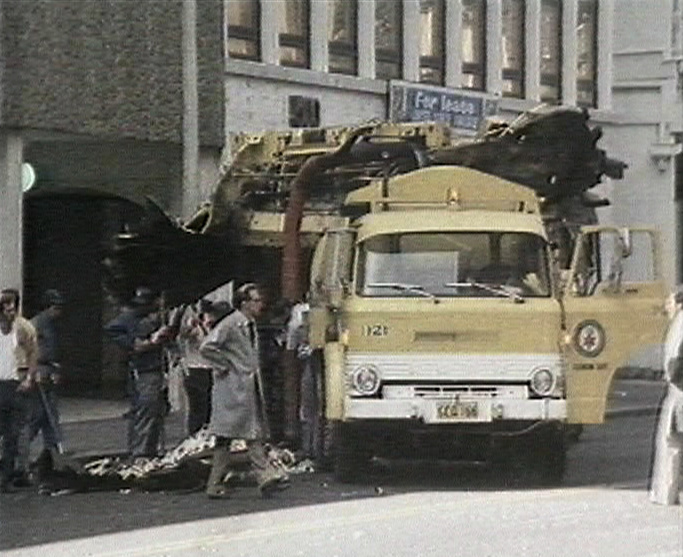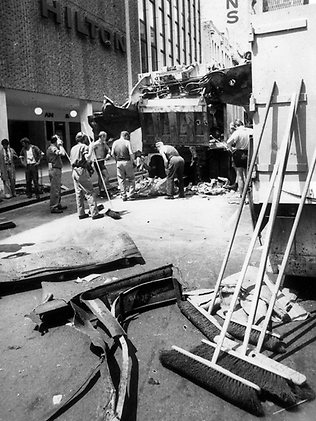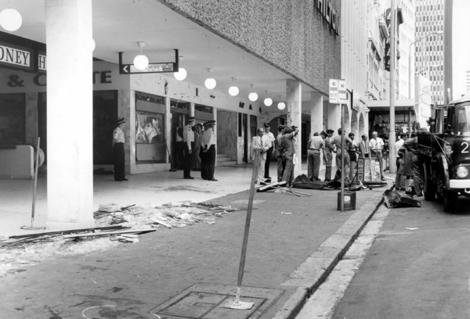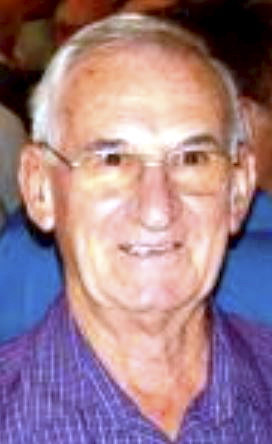Paul BURMISTRIW
Paul BURMISTRIW
The FIRST Terrorist act in NSW
NSW Police Academy, Redfern – Class 128
New South Wales Police Force
Regd. #: 14872
Rank: Commenced Training at Redfern Police Academy on Monday 9 August 1971 ( aged 25 years, 1 month, 4 days )
Probationary Constable – appointed 20 September 1971 ( aged 25 years, 2 months, 15 days )
Constable – appointed 20 October 1972 ( loss of 1 month Seniority possibly failing an exam or physical )
Constable 1st Class – death
Stations: ?, Regent St ( 2 Division ), Central Police Stn ( 1 Division – A District ) – Death
Service: From 9 August 1971 to 22 February 1978 = 6 years, 6 months, 13 days Service
Awards: No find on It’s An Honour
Born: Friday 5 July 1946
Event date: Monday 13 February 1978
Died on: Wednesday 22 February 1978
Cause: Bomb Explosion – Terrorist Act – Murdered
Event location: Sydney
Age: 31 years, 7 months, 17 days
Funeral date: Monday 27 February 1978
Funeral location: Russian Orthodox Church, Strathfield, NSW
Buried at: Rookwood Cemetery
Zone H Remembrance Lawn 1 Grave 456
Memorial location: outside of Hilton Hotel, George St, Sydney
PAUL IS mentioned on the Police Wall of Remembrance
Constable Burmistriw was fatally injured in a bomb explosion outside the Hilton Hotel, George St, Sydney, on 13 February, 1978. At the time the Regional Conference of Commonwealth Heads of Government meeting (CHOGM), a regional off-shoot of the biennial meetings of the heads of government from across the Commonwealth of Nations. was taking place at the hotel.
The bomb, planted in a rubbish bin, exploded when the bin was emptied into a garbage truck outside the hotel at 1:40am. It killed two garbage men, Alec Carter and William Favell, and a police officer, Paul Burmistriw, guarding the entrance to the hotel lounge, who died of his injuries on the 22 February 1978.
The blast also injured eleven others. Twelve foreign leaders were staying in the hotel at the time, but none were injured. Australian prime minister Malcolm Fraser immediately called out the Australian Army to guard the remainder of the CHOGRM meeting.
Also seriously injured in the blast were Sergeant Edward Hawtin, Senior Constable Rodney Wither ( Regd # 16376 ) and Senior Constable Terry Griffiths ( Regd # 13390 ). Two council employees, William Arthur Favell and Alec Carter, were also killed in the bombing.
The constable was born in 1946 and joined the New South Wales Police Force on 20 September, 1971. At the time of his death he was stationed at Central Police Station.
Startling book unpicks story behind Australia’s first major terrorist attack
ONCE upon a time, Australia was truly the carefree, “lucky country” of our imagination. Now, we walk around on edge, knowing we are by no means protected from people who would do us harm.
If you thought that started with the Sydney siege, you’d be wrong. What is seen as the first major act of terrorism on Australian soil took place 30 years ago, and it remains unsolved to this day.
Author and award-winning filmmaker Dr Rachel Landers has dived into the archive documents on the Hilton bombing, trying to make sense of all the contradictory testimony surrounding that black day.
On February 13, 1978, a bomb was planted in a rubbish bin outside the Sydney Hilton, which was hosting a Commonwealth meeting of Asia Pacific heads of government.
The device exploded when it was loaded into a garbage truck, blowing the vehicle to pieces, along with two rubbish collectors, Alec Carter and William Favell. A police officer guarding the entrance to the hotel lounge, Paul Burmistriw, died later. Eleven more were injured.
It was a day that left people physically and mentally scarred, tore families apart and was a devastating blow to the happy-go-lucky Australian psyche. It triggered years of finger-pointing, conspiracy theories and saw several innocent men locked away.
Dr Landers’ book, Who Bombed The Hilton?, takes us back to an event that helps explain our nation today.
CONSPIRACY THEORY
As with terrorist attacks like 9/11, shocking claims emerged soon after the tragedy that Australian security forces had planted the bomb themselves.
One of the most vocal conspiracy theorists is policeman Terry Griffiths, who was badly mutilated by the blast, and questions the authorities’ story to this day.
The allegations, which have gained enough credence to be recorded in meticulous detail across the internet, centre on what some see as suspicious aspects of the story, including: why police outside the hotel didn’t see a bomber, why didn’t they search the bins, why they allegedly stopped garbage trucks emptying the bins, why a bomb squad was waiting, why a “warning call” wasn’t relayed to police outside the hotel and where the truck was dumped afterwards.
Dr Landers accepts that police made mistakes, and that the New South Wales police force had a problem with corruption at the time, but she says nothing she found in documentary evidence backed up Mr Griffiths’ claims.
She decided early on to eliminate witnesses’ recollections and instead focused on a forensic analysis reams of archival material made public 20 years ago. “Memory is an unreliable thing,” she said. “People misremembered basic facts. There was a huge discrepancy in what they recalled.
“There were appeals and counter-appeals. They tell a story about a miscarriage of justice that is not untrue, but covers up the question of who is actually the most likely person to have planted the bomb.”
MAKING THREE MURDERERS
Days after the bombing, a man named Richard Seary approached police and offered to infiltrate an Indian socio-spiritual organisation called Ananda Marga, who were demonstrating against the outside the hotel at the time.
In June, Seary told police that members Paul Alister, Tim Anderson and Ross Dunn had confessed to the bombing, and it was assumed Indian Prime Minister, Morarji Desai, was the target.
Seary said they were planning another attack on Neo-Nazi National Alliance leader Robert Cameron. The mole led police to the trio, in a car packed with explosives, and they were arrested. They were never convicted of the Hilton bombing, but were given 16 years each for conspiracy to murder Cameron.
It later emerged that Seary was a paranoid schizophrenic and drug addict, who had planted the explosives in the car. Alister, Anderson and Dunn were released after seven years in prison. It remains one of Australia’s worst miscarriages of justice.
While they received compensation, Alister told the Sunshine Coast Daily in 2008 he was sick of being referred to as a Hilton bomber.
Most officials now believe an Ananda Marga member named Abhiik Kumar, living in Israel, is behind the bombing. But the trail has long since gone cold and is “besieged by contradictions and evidentiary problems.”
The authorities failed to share their plans with international colleagues working on possible related bombings and attempted attacks and “it was catastrophic for the case, it totally derailed it,” according to Dr Landers.
“Special branch, for understandable reasons, went rogue,” she said. “People were so shocked, they’d been thrust into the international age of terrorism. People do irrational things in that vortex of fear.”
LONG FIGHT FOR TRUTH
Like today’s acts of terrorism, carried out in the name of Islamic State or other jihadi groups, the Hilton bombing didn’t take place in a vacuum.
“A lot of things I thought I knew turned out to be untrue,” said Dr Landers. “I always thought it was a really Australian story, I didn’t realise we were at the centre of an international reign of terror.
“There was a huge mountain of evidence linking this with Stockholm, New York, Malaysia … There are letters from Afghanistan threatening India. It quickly stopped being about Australia.”
The bombing was politicised so early on, it is hard to dig down to what really happened, but it’s a story that needs to be told without the agenda.
Dr Landers has conducted a thorough investigation, and she believes she has some answers, but she wants those touched by the tragedy to have the public inquiry they deserve.
As the threat of terrorism looms ever larger, we have a real chance to learn from our past.
Who Bombed the Hilton? is officially launched on Wednesday April 20.
http://forum.prisonplanet.com/index.php?topic=88905.0
The Warning Phone Call
The Hilton Operation ran strictly according to plan up until 12.30AM on the Monday morning. Two garbage pick-ups were prevented by the NSW police. Whoever planted the bomb was well aware of the garbage collection times. Another garbage collection was due at 1AM Monday morning. At 12.30AM the warning phone call was made. (Terry Griffiths says another police officer told him the warning phone call was made by a Sergeant in Special Branch who had been observing the scene outside the Hilton in a red torana, a police observation car. The warning phone caller rang the police switchboard and asked to speak to Special Branch. It was 12.30AM Monday morning. Normally, Special Branch would not be there at that hour, though the phone caller seemed to believe they would be. (Indeed, the same person called back an hour later at 1.30Am and again asked to speak to Special Branch.) After the phone rang a few times, the police telephonist transferred the call to the sergeant in charge of the CIB, Cec Streetfield. The Hilton Operation had begun to unravel.
What Streetfield did on being informed of the bomb, is one of the mysteries of the Hilton. What he did not do is notorious: he did not warn the police outside the Hilton over the police radio. Streetfield testified before the Hilton Inquest in 1982. According to Terry Griffiths, he told a pack of lies. According to Streetfield, the phone caller said: “Dere is a bomb in der bin outside der Hilton Hotel.” The phone caller then rang the Sydney Morning Herald and told them they might be interested in what was about to happen outside the Hilton Hotel. The Hilton Operation continued to fall apart. The garbage collection truck was running twenty minutes early that night. They arrived outside the Hilton at 12.40AM before the bomb was found.
City of Sydney Re-dedicates Plaque Commemorating Hilton Hotel Blast Victims
The City of Sydney is re-dedicating the plaque commemorating the victims of the Hilton Hotel bombing on the occasion of the 30th anniversary of the event.
The bombing at the Hilton Hotel occurred in the early hours of 13 February 1978. The bomb was concealed inside a garbage bin and exploded when that bin was loaded into a City of Sydney Council garbage truck compactor.
Three people were killed (Alec Carter and Arthur Favell, City Council workers, and a NSW Police Officer, First Class Constable Paul Burmistriw) and seven more were wounded. At the time, Malcolm Fraser, the Prime Minister and eleven visiting heads of state were staying at the hotel for a Commonwealth Heads of Government Meeting.
Lord Mayor, Clover Moor MP said that the anniversary of the bombing served as a time to remember those whose lives were cut short and those who still bear the scars today.
“This terrible act killed three decent and dedicated men, two of whom were working for the City of Sydney. But now we can re-dedicate this plaque so that future generations remember them and remember the shocking crime that took their lives.”
Commissioner of Police Andrew Scipione APM said it was important that Australians not forget the terrible incident.
“This was the death of a policeman killed as he helped guard world leaders in Sydney. Constable Paul Burmistriw was a fine officer. That he and City Council workers Alec Carter and Arthur Favell should die doing their job was a terrible tragedy.”
The original plaque had stood on the site of the garbage bin but had been moved due to a City streetscape upgrade and the recent upgrade of the Hilton Hotel. The new plaque will stand at the original spot on the George Street footpath.
Hilton Hotel Bombing History
In February 1978, Prime Ministers and other heads of State and senior political figures from Commonwealth countries gathered in Australia for a Commonwealth Heads of Government Meeting, known as CHOGM, held at Sydney’s Hilton Hotel.
In the early hours of 13 February 1978, a City of Sydney garbage truck compactor set off a bomb that had been placed in a bin immediately outside the Hilton Hotel on George Street.
At the time Australian Prime Minister Malcolm Fraser and eleven visiting heads of state were staying at the hotel.
Three people were killed by the blast: two City of Sydney Council workers, Alec Carter and Arthur Favell and First Class Police Constable Paul Burmistriw.
Seven people were wounded by the blast, including police officer, Terry Griffiths.
The then Indian Prime Minister, Morarji Desai claimed that the blast was the work of a group known as Ananda Marga, protesting the imprisonment in India of their spiritual leader, Shrii Shrii Anandamurti.
In 1989, Evan Pederick came forward and claimed responsibility for the bombing. He accused a one-time member of Ananda Marga, Tim Anderson of helping to plant the bomb. The only other main witness against Anderson was notorious criminal Raymond John Denning. Anderson went on trial in 1990 and was initially found guilty.
Anderson appealed to the NSW Court of Appeal. On 6 June 1991 the court led by then Chief Justice Gleeson quashed the conviction, based on the inappropriate and unfair action by the crown prosecutor. His Honour noted: “It is well established that a Court of Criminal Appeal may treat a jury’s verdict as unsafe or unsatisfactory even if satisfied that it was, on the evidence, reasonably open to the jury to convict … The inherent strength or weakness of the crown case may be a factor relevant to such a conclusion. In the present case, for reasons just given, I do not regard the crown case as presented at trial as a strong one, and for the reasons discussed in relation to the first ground of appeal, there was one important respect in which, in my view, the proceedings miscarried. The crown was permitted, in an unfair manner, to obscure a major difficulty concerning the reliability of the evidence of its principal witness by raising an hypothesis that was not reasonably open on the evidence.This was compounded by what I regard as an inappropriate and unfair attempt by the crown to persuade the jury to draw inferences of fact, and accept argumentative suggestions, that were not properly open on the evidence. I do not consider that in those circumstances the crown should be given a further opportunity to patch up its case against the appellant. It has already made one attempt too many to do that, and I believe that, if that attempt had never been made, there is a strong likelihood that the appellant would have been acquitted.”
There has been controversy about the motives for the planting of the bomb and the handling of the case that surrounded it. Terry Griffiths has claimed that the bombing was a conspiracy and called for an inquiry. There have been persistent suggestions of ASIO involvement in the bombing.
Anderson subsequently lodged 52 complaints of professional misconduct with the New South Wales Bar Association against Mark Tedeschi, QC. All but one of the complaints by Anderson against Tedeschi were dismissed by the NSW Bar Association. The remaining complaint was dismissed by the NSW Administrative Decisions Tribunal.
In 1991, Peter Collins, the then NSW Attorney-General led a campaign to demand a joint State-Federal inquiry which culminated in a unanimous resolution by both houses of the NSW parliament. Mr Collins said in parliament: “The Hilton bombing cannot simply be relegated to the yellowing pages of history until we know the truth, however unpalatable it may turn out to be. It must also be said that we owe this to the memory of the three who perished, their families, and to those who survived… This issue, this weeping sore transcends political, constitutional and geographical boundaries. The answers may be alarmingly simple. But, whatever the truth, the people of Australia are entitled to nothing less.”
Hilton Hotel bombing victims remembered with plaque
- The Daily Telegraph
- February 13, 2008
A PLAQUE, commemorating the victims of the Hilton Hotel bombing on the 30th anniversary of the event, will be re-dedicated in Sydney today.
The City of Sydney is re-dedicating the plaque, which pays tribute to three people who were killed in the blast, after a recent street upgrade and redevelopment of the Hilton Hotel.
City Council workers Alec Carter and Arthur Favell, and a NSW Police Officer, First Class Constable Paul Burmistriw were killed.
Seven others were wounded in the blast.
The bombing at the Hilton Hotel occurred in the early hours of 13 February 1978.
The bomb was concealed inside a garbage bin and exploded when that bin was loaded into a City of Sydney Council garbage truck compactor.
At the time, Malcolm Fraser, the Prime Minister and eleven visiting heads of state were staying at the hotel for a Commonwealth Heads of Government Meeting.
Lord Mayor, Clover Moore MP said that the anniversary of the bombing served as a time to remember those whose lives were cut short and those who still bear the scars today.
“This terrible act killed three decent and dedicated men, two of whom were working for the City of Sydney.
“But now we can re-dedicate this plaque so that future generations remember them and remember the shocking crime that took their lives.”
Commissioner of Police Andrew Scipione APM said it was important that Australians not forget the terrible incident.
“This was the death of a policeman killed as he helped guard world leaders in Sydney.
“Constable Paul Burmistriw was a fine officer.
“That he and City Council workers Alec Carter and Arthur Favell should die doing their job was a terrible tragedy.”
The plaque will stand at its original spot on the George Street footpath when it is unveiled at 2.30pm today.
Australian terrorism born in the Sydney Hilton bombing
- Herald Sun
- December 21, 2012
IT was Australia’s first terrorist attack, but amid a string of plot twists many believe that more than three decades later, there are still many unanswered questions.
The terror that struck in the heart of Sydney began on a warm summer night in February, 1978.
Australian Prime Minister Malcolm Fraser and the leaders of 11 heads of state were staying at the Sydney Hilton Hotel the night before the Commonwealth Heads of Government Meeting (CHOGM).
Just after midnight, a garbage truck pulled up outside the front of the hotel to empty a bin overflowing with rubbish.
As the truck’s hydraulic ram dropped to compress the rubbish, it detonated a 6.5kg bomb that had been in the bin in a blast that tore through the early-morning serenity of the CBD.
In Melbourne’s The Herald, Peter Coster – who now writes for the Herald Sun – described the effect of the blast.
“Everyone in the vicinity was temporarily deafened. Blood is everywhere outside the entrance to the hotel …”
The blast shattered windows on both sides of the street, with debris flung 100m either side of the hotel entrance.
Garbage collectors William Favell and Alex Carter died in the blast. Police officer Paul Burmistriw died nine days later from head injuries, and nine others were seriously injured.
The autopsy report found Mr Favell’s body was “shattered”.
“The parts were badly shattered with hardly any bone left intact. Embedded in the body were large amounts of foreign matter such as cigarette butts, labels, etc. There was also shrapnel, glass, splinters and paint, The National Times reported.
When the blast hit, the nation’s leaders inside the hotel were shocked into action.
Australian Foreign Minister Andrew Peacock ran to the Prime Minister’s room.
Grabbing dressing gowns on their way out, the pair rushed to the scene of the explosion in their pyjamas
Mr Fraser told the public: “At this stage it must appear that the dead and injured are utterly innocent victims of a senseless act of violence.”
It was also reported a warning phone call was made to police minutes before the explosion, in the first hint that there was more to the story.
[blockquote]We will never be stopped. Ananda Marga will cleanse the world[/blockquote]
And so began the controversy.
Overnight, Sydney went into lockdown amid the biggest manhunt in Australia’s history.
Mr Fraser and the NSW Premier Neville Wran demanded support from the armed forces, and almost 2000 troops descended on the city for protection.
CHOGM progressed with armed forces and even a decoy train employed to protect heads of government on their way to a pretty NSW town, Bowral.
Mr Coster recalls Bowral was “transformed into a war zone” with helicopters flying overhead through the night and armoured personnel carriers along the road into town.
Police were now hunting three men “swarthy in appearance and in their early 30s”.
Within hours, suspicions emerged that a previously ignored religious sect known as Ananda Marga appeared to have played a role in the bombing.
Margis -as the sect’s members were known- had already been involved in worldwide protests for some years, demanding the Indian government release their spiritual leader Pabhat Ranian Sarkar who was serving a life sentence for murder.
But the breakthrough came after the three main suspects were charged in another political conspiracy four months later.
On June 15, Ross Dunn, 24, Paul Alister, 22, and Timothy Anderson, 26, were charged with conspiring to murder the NSW leader of the National Front – a professed Nazi – Robert Cameron.
All were members of Ananda Marga’s Australian branch.
The trio were sentenced to 16 years’ jail without parole.
But the trials also unearthed police informer, Richard Seary, 26, who implicated them in the Hilton bombing.
Mr Seary, a reformed heroin addict, revealed he had joined Ananda Marga as a paid police informer in March 1978 to discover any links between the sect and the bombing.
The men told him they had “fixed” the Hilton bombing, and Anderson had also declared: “You’ve got to be willing to die for your ideology.”
An arresting detective said Dunn had also told him: “We will never be stopped. Ananda Marga will cleanse the world.”
But despite a $100,000 reward and a team of 100 full-time detectives, no charges had been laid for the Hilton bombing a year after the blast.
Three early leads had been discounted, including a theory that a woman was suspected of trying to harm the New Zealand prime minister because she opposed the abortion laws.
Three years after the bombing, new evidence suggested a cover-up.
On March 30, 1981, newspapers reported that the NSW Attorney-General had received fresh information.
Among the new claims was that an army bomb disposal squad had been on its way to the Hilton when the bomb exploded. Another allegation was that the police hadn’t searched the garbage bins the night before the blast, in an otherwise comprehensive search.
Enter the Hilton bombing’s most vocal conspiracy theorist.
Retired senior constable Terry Griffiths had been just six metres from the blast and suffered extensive injuries.
The father of two, who had been battling for worker’s compensation for over two years, believed he was the victim of a cover-up involving Australian security forces.
Mr Griffiths said the NSW Government had deliberately blocked his efforts to seek compensation.
“I’m suggesting there is enough evidence for any person who wishes to go into the matter honestly to believe that there may well be a cover-up in this matter.”
Some evidence appeared to support his theory.
It emerged that three garbage trucks were diverted from the bin by police officers, despite the fact that it was overflowing with rubbish.
Mr Griffiths even claimed the explosion was the inadvertent result of a media stunt fabricated by ASIO, the military and the NSW Police Special Branch.
His theory was that the organisations had planted the bomb which they then intended to “discover” to make them look good – and justify broader powers, he told Sydney’s The Sun-Herald.
It was only when the ill-fated fourth truck slipped through and finally emptied the bin that the “plan” went badly awry.
Mr Griffiths suggested that the phone call police received just minutes before the blast was in fact a person involved who saw the truck approach the bin, and panicked.
Mr Griffiths said ASIO had benefited from the blast, gaining “unlimited powers” from legislation introduced in the wake of the blast.
Some politicians gobbled up Mr Griffiths’ allegations of conspiracy, including then-Senator and federal shadow Attorney-General Gareth Evans.
Within a month there were calls for fresh investigations into the Hilton bombing and the reward raised to $250,000.
Then, in 1982, a coronial inquest was announced.
The Sydney Hilton’s night receptionist at the time of the blast, Manfred von Gries told the inquiry he saw three men speaking to police just before the explosion.
Within days, he was approached by a man who threatened to kidnap his son if he spoke to police about what he saw, he claimed.
He later identified the man as Jason Alexander, Ananda Marga’s Australian leader, but there were doubts about his evidence.
Mr Griffiths added to his claims, suggesting a bomb disposal truck was stationed around the corner before the blast, and that several Special Branch officers were watching the police from a vehicle across the road.
He also said he’d been informed that a warrant officer with the armed forces had planted the bomb several days before the blast.
Mr Griffiths also said that Sgt Robert Jackson, his friend and fellow officer who had assisted with the initial murder investigation, had told him that the warning call was made to police 10 minutes before the blast.
Within days, Sgt Jackson denied the conversation.
Sgt Arthur Hawkin, on duty on the night of the blast, appeared to back the theory.
Mr Hawkin said when he arrived for his shift 90 minutes before the explosion he was told to expect trouble and “something about a bomb”.
The inquiry also heard a sergeant before the blast saw Timothy Anderson near the rubbish bin that later exploded, during a demonstration against the New Zealand prime minister.
And another witness claimed Anderson, a regular customer, had picked up a newspaper in her shop the morning after the blast and had said to another man: “We only got three.”
Then the police informant Richard Seary dropped powerful new claims, saying Ross Dunn had told him he’d planted the bomb in the bin an hour before the Indian Prime Minister’s arrival.
Why hadn’t Mr Seary shared this evidence with police earlier?
Initially, he said it was because he was upset with the way police had treated him. Later, he said it was due to concerns that Dunn had lied, confessing out of bravado.
He said on account of his doubts, he had drip-fed his evidence to police instead.
With the latest claims, coroner Norman Walsh decided there was enough evidence to charge Dunn and Alister of three counts of murder, and Anderson with conspiracy to murder.
The court erupted in shock and fury, and even the jury, which gave no official verdict raised lingering questions.
In 1984, the NSW Attorney-General Paul Landa on Crown law advice decided the three men would not be prosecuted.
Instead, a judicial inquiry was announced to investigate the Cameron charges.
This inquiry found Richard Seary to be an unreliable witness, and a psychiatrist diagnosed him as having a personality disorder.
Adding to his fall from grace, the Margis’ lawyer went so far as to accuse Mr Seary of bombing the hotel himself.
In 1985, after seven years in jail, the judicial inquiry quashed the trio’s convictions.
The three men were released in May, pardoned by the NSW government, and awarded $100,000 each in compensation.
Alister and Dunn moved to an Ananda Marga community in Queensland, and Mr Anderson was left to pursue a PhD on Australian foreign debt.
But on May 30, 1989, Anderson was again arrested and charged for the bombing amid new evidence.
Evan Dunstan Pederick, a 33-year-old Brisbane public servant Ananda Marga member admitted he had tried to remotely detonate the bomb when the Indian Prime Minister arrived at the hotel.
He said he was acting as a front man for Mr Anderson, who provided the explosives.
When the bomb failed to detonate, Pederick panicked and ran. He pleaded guilty to conspiring to murder the Prime Minister – but not guilty to causing the three subsequent deaths.
Nevertheless, Pederick was found guilty of three counts of murder, and sentenced to 20 years’ jail. The jury determined he had acted with reckless indifference by leaving the bomb in the bin.
Another prisoner who had met Mr Anderson while he was serving the Cameron sentence revealed Anderson had confessed his role in the Hilton bombing.
In 1990, Anderson was sentenced to 14 years’ jail. Supreme Court justice Michael Grove said Mr Anderson had been “brainwashed” by the Ananda Marga cult when he instigated the bombing.
Seven months later Mr Anderson was acquitted.
But the saga was far from over.
In May 1995, Pederick did a U-turn. After six years in jail for a crime he confessed to, it suddenly occurred to Pederick that he might be innocent.
Pederick accused police of failing to test his evidence and state of mind.
“Is it possible that in 1978, dominated by the influence of the Ananda Marga and yet in conflict with the demands of the sect, I had acquired a deep sense of guilt which expressed itself in an obsession with the cataclysmic events for which Ananda Marga was held responsible at the time? I do not know,” Pederick said in a News Ltd report.
In 1997, the NSW Court of Criminal Appeal dismissed Pederick’s new claims, but six months later he was released on parole.
”As a naive young person, influenced by the teachings of Ananda Marga, I participated in a fatal act of political terrorism,” Pederick said, as quoted in The Australian.
But as he left the jail, Pederick indicated there were six others involved in the bombing, none of whom were ever charged.
More than three decades on, the question mark remains: Who bombed the Sydney Hilton?
Police-coroner collaboration on Hilton revealed
By Dick Nichols and John Tognolini
SYDNEY — In evidence before the New South Wales Independent Commission Against Corruption, it has emerged that state coroner Kevin Waller advised Detective-Inspector Aarne Tees, investigator of the Hilton bombing, on whether the testimony of police informer Raymond John Denning provided a strong enough basis for a prosecution of Tim Anderson.
Anderson was convicted in November 1990. His appeal was unanimously upheld by the NSW Court of Criminal Appeal in May 1991, Chief Justice Gleeson ruling that “a jury, acting reasonably, would give Denning’s evidence little or no weight”.
The involvement of Waller in the Hilton case again highlights the links between the police and the judiciary in this state. In evidence, Tees stated that he didn’t trust crown law officers (who would normally make judgements on the reliability of testimony) and instead sought the opinion of Waller because he was “technically the head of homicide”.
Waller’s view that Denning’s evidence was trustworthy contrasts with his ruling in a previous case involving Denning, once known for his championing of prisoners’ rights.
In 1981-82 Waller heard a case brought by prisoners’ rights activist Brett Collins against certain warders at Grafton Jail. One of the witnesses called by Collins was Denning. In his adjudication, Waller said:
“In cross-examination he demonstrated a bizarre attitude to life … Mr Denning has been in institutions, in gaols, committing crimes or on the run for the last 15 of his 30 years and his attitude must have been affected by his life style. At other times he refused to answer questions in cross examination despite warnings that such refusals could reflect adversely on his credit. He was an unreliable witness.”
The revelation that Tees consulted Waller on using Denning also went against Tees’ own evidence to the committal hearing against Anderson, held in September 1989. There Tees denied having been advised by anyone before launching the prosecution.
In other evidence before the ICAC, it has emerged that the prosecution decided not to call five other prisoner witnesses against Anderson, even though all claimed that Anderson had confessed to the Hilton bombing when in jail. A coded message between two of these witnesses, which was intercepted by prison officers, read: “It’s nice to know we can get someone convicted even when he is innocent like Anderson is. They’re all gronks [dags].”
Someone on the prosecution side decided that such people wouldn’t make very reliable-looking witnesses for the prosecution.
Also of interest is the revelation that Anderson’s supposed confession to the five uncalled witnesses revolved around an alleged conflict between Anderson and fellow prisoner Alex Burmistriw, the brother of Constable Paul Burmistriw, killed in the Hilton bombing.
In her notes of an interview with Alex Burmistriw, Anderson’s solicitor wrote: “He said that the police had come to see him and they dared to say that he didn’t care for his brother. He [Burmistriw] asked about whether he is supposed to have got in a fight with Tim — I said in fact yes, that was one of the allegations. He said something like, if he had, Tim would have known about it.”
Little of this has appeared in the Sydney media. They have led with Denning’s challenge to Anderson to undergo a lie-detector test and Tees’ claim that Anderson and the Prisoners Action Group were involved in spiriting prison escapee Ian Steele out of the country in 1986.
Commissioner Ian Temby halted Tees’ evidence on this matter, saying he did not want the hearing to be “used as a vehicle for the bringing forth of material which is of no possible use to me and all it does is to titillate various imaginations“.
In a letter to the Sunday Telegraph, Brett Collins and Ian Fraser replied on behalf of the Prisoners Action Group: “Denning’s accusations elsewhere have been dismissed or totally contradicted by proven facts as in the Hilton bombing case. We regard his actions as sadly exhibiting the destructive influence of heroin, prison hopelessness and corrupt authorities.”
In his opening remarks, Tim Anderson said that his questioning of Denning would reveal a “a pattern of constructing evidence to make it incriminate people with the help of Aarne Tees“.
Will the ICAC hearings get to the bottom of the police informer system? Will anyone important be charged? The signs are not very promising. Already Commissioner Temby has refused requests for chief Hilton prosecutor Mark Tedeschi and Kevin Waller to appear before the hearing.
https://www.greenleft.org.au/content/police-coroner-collaboration-hilton-revealed
